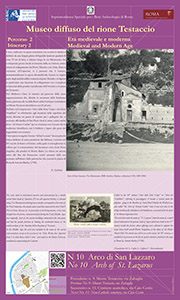

![]()

Between the 5th and the 7th century AD, the plain was involved in a gradual process of ruralization, and since the Middle Ages it was used for setting up vegetables gardens and vines. A part of the present “rione” was left as public recreation ground, and was therefore known with the name “Prati del Popolo Romano” (Meadows of Roman People). The Monte dei Cocci represent a passageway to the Medieval and Modern age, when was turned in a place for the Carnival and was used also for the representation of Mount Calvary during the via crucis, as reminded by the cross that is present on its peak. In the XVII century the medieval vegetable gardens were turned into vines and the foot of the hill was excavated and converted into "warehouses" for the conservation of wine. The first evidence of the “caves” dates back to 1667, while the last license dates back to 1685.
Since the XVIII century, for its suburban position, a part of the "Meadows of the Roman People" are intended for the burial of Protestants who could not be buried inside the sacred land: this is how the "English Cemetery" was created. It is also know with the name of Non-Catholic Cemetery. It is very popular among European tourists and buried there among other are the poets P. B. Shelley and J. Keats, the writer C. E. Gadda and Antonio Gramsci, founder of the Italian Communist party.